-
Pros
- Affordable
- Easy to use
- Instax Wide print format
- Moderately wide lens with two focus zones
- Color and monochrome film options
- Convenient AA battery power
-
Cons
- Bulky frame
- Omits manual controls
- No multiple exposure or bulb mode
Fujifilm Instax Wide 400 Specs
| 35mm Equivalent (Wide) | 35 |
| Battery Type | AA |
| Dimensions | 4.8 by 6.4 by 3.9 inches |
| Memory Card Format | Fujifilm Instax Wide |
| Stabilization | None |
| Type | Analog |
| Viewfinder Magnification | 0.37x |
| Viewfinder Type | Optical |
| Weight | 1.4 |
As the first of its kind in nearly a decade, the $149.95 Fujifilm Instax Wide 400 instant camera is a welcome replacement for the veteran Wide 300. Despite the time gap and a total exterior redesign, the latest version shares a lot with its predecessor: It uses the same optics, provides fully automatic exposure, and offers a simple, one-button operation. A close focus option is new, but we would have also liked some additional creative flexibility. We're glad to see Fuji return its attention to this neglected film format, but if you want to manually control the exposure, make multiple-exposure photos, or connect to an off-camera flash, you are better off with the Editors' Choice Lomography Lomo'Instant Wide for $199.99, despite its age.
Design: Big Film Makes for a Big Camera
The type of film an analog instant camera uses dictates its size. And, as far as currently available materials go, film doesn't get any bigger than Instax Wide. The instant film has a 3.9-by-2.4-inch image area and a border, so it requires an oversized camera to hold it and a big lens to cover it. For reference, Instax Wide falls a little shy of what most consider large format (4 by 5 inches). The film's surface area is nearly seven times as large as that of 35mm film and full-frame digital sensors.
 (Credit: Jim Fisher)
(Credit: Jim Fisher)The Wide 400 is quite big and chunky as a result, coming in at 4.8 by 6.4 by 3.9 inches (HWD) and 1.4 pounds. Other cameras that use this film have similar footprints, including the Lomo'Instant Wide (5.8 by 7.5 by 3.8 inches, 1.6 pounds) and the $899 Mint InstaKon RF70 (4.8 by 7.2 by 2.5 inches, 1.8 pounds).
If you find any of those too much to carry, then Instax Wide isn't the format for you. Fuji makes two other types of Instax film, both of which are smaller. The Instax Square SQ1 (4.7 by 5.2 by 2.3 inches, 13.9 ounces) uses Square format film with a 2.4-by-2.4-inch picture, while the Mini 99 (4.4 by 4.0 by 2.1 inches, 14.0 ounces) uses Mini format film with a 1.8-by-2.4-inch area. The hybrid digital-analog Mini Evo Hybrid (3.4 by 4.8 by 1.4 inches, 10.0 ounces) also takes up far less room in your gear bag.
 (Credit: Jim Fisher)
(Credit: Jim Fisher)As for other film formats from other brands, Polaroid's 3.1-by-3.0-inch I-Type film is the only one that competes with Instax Wide on size. But I-Type film loads into the bottom of compatible cameras, so they don't need to be as large. The entry-level Polaroid Now+ (3.7 by 4.2 by 5.6 inches, 1 pound), for example, feels much smaller than the Wide 400 thanks to its squatter silhouette.
It isn't difficult to load film into the rear of the Wide 400 since both the cartridge and camera include a yellow line that helps you match them up. The door closes securely and requires you to twist a metal lock clockwise to open its latch. The latter is a small, but welcome detail. Other instant cameras, including the Wide 300 and Lomo'Instant Wide, rely on plastic clips to keep the film door shut.
 (Credit: Jim Fisher)
(Credit: Jim Fisher)The Instax Wide 400 goes for a completely different aesthetic than the Wide 300. The latter is unattractive by modern standards, with a two-tone finish that doesn't nearly scratch the same retro itch as Fuji's stunning X100VI digital compact. Moreover, the handgrip and optical viewfinder jut out oddly from the body.
 (Credit: Jim Fisher)
(Credit: Jim Fisher)Meanwhile, the Wide 400 borrows its looks from the unicolor SQ1, and both the viewfinder and grip look and feel like more than an afterthought. It's available only in a green hue that reminds me of a desaturated key lime pie. I like the look—it's neither flashy nor dull. The body feels comfortable and premium, too, despite the all-plastic build.
The Wide 400's handgrip houses a battery compartment for four AA batteries. Disposable batteries are standard for instant cameras, and I see the choice to use AA cells as a positive since they are readily available. A set of batteries should take you through roughly 10 packs of film (or 100 exposures). The camera's helpful, five-minute auto-shutdown feature means you don't have to worry about accidentally leaving it on between photo sessions.
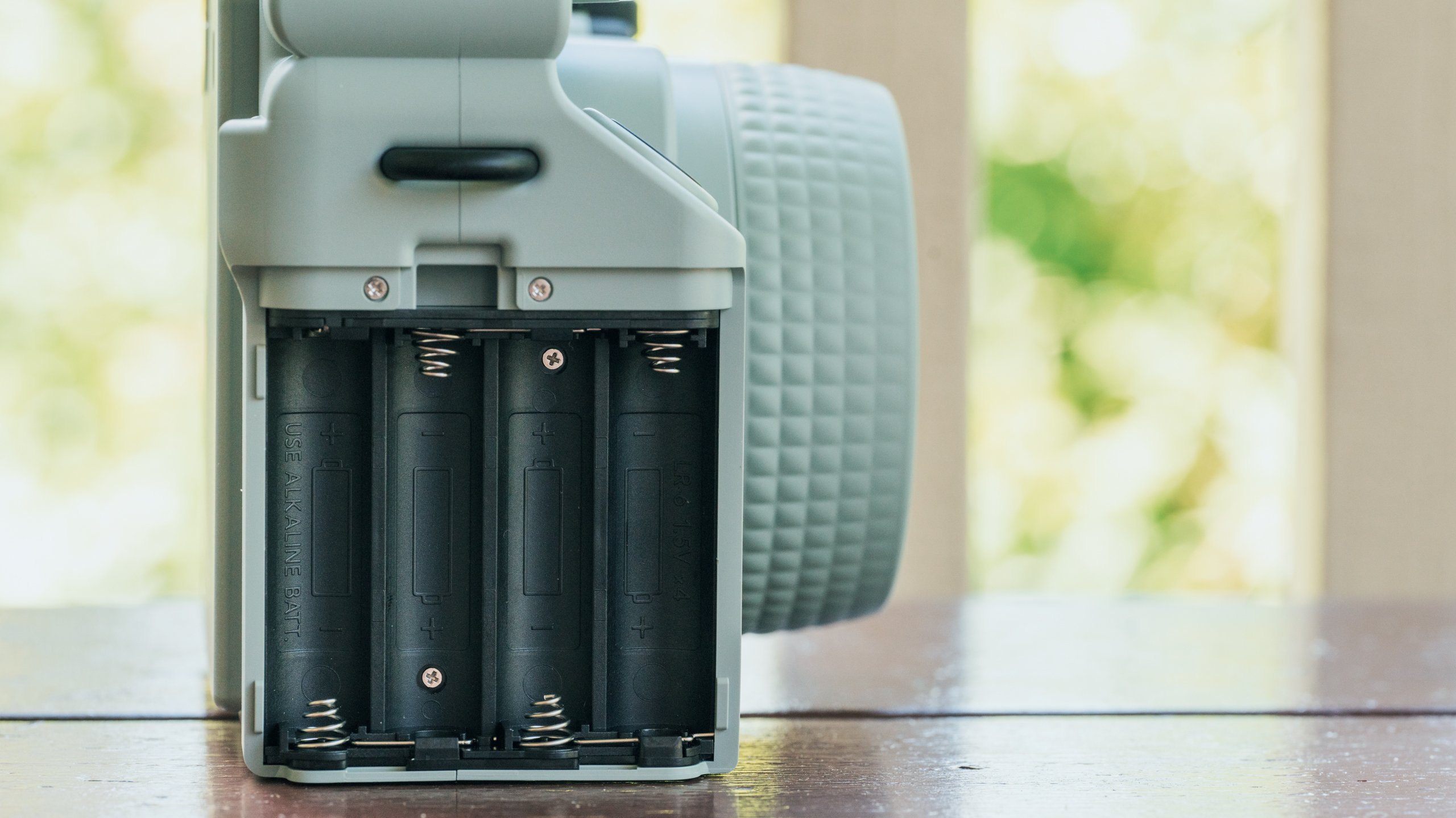 (Credit: Jim Fisher)
(Credit: Jim Fisher)Controls: Fully Automatic Exposure, Manual Focus
There's not much going on in terms of controls. The Wide 400 is a one-button camera and doesn't offer any manual exposure settings. The shutter is part of the handgrip and set at a comfortable 45-degree angle so it falls naturally under your finger. An integrated sensor reads ambient light to decide if the flash should fire; you can't turn it on or off manually. You don't get EV compensation, either. This limits creative control compared with others that have some manual overrides. If you want more exposure control, the Fujifilm Instax Mini 99 lets you toggle the flash output and adjust the EV setting.
 (Credit: Jim Fisher)
(Credit: Jim Fisher)You do get a self-timer, however, which you set with a dial to the left of the lens. Five bright orange LEDs nearby turn off in succession to indicate the countdown. The timer works as expected, and you can use the four click stops to set a delay of 4, 6, 8, or 10 seconds. These LEDs double as a battery indicator by alternating between a slow and quick strobe pattern when the battery is low. The topmost light burns solid orange when the camera has ample power and is ready to take a photo.
The grip provides a strong purchase over the large camera, so I didn't have to worry about dropping it. The included neck strap and wrist strap are a little narrow and short, however. It's easy enough to attach a different strap since the lugs are wide enough to accommodate most aftermarket options. I used a Peak Design Slide Lite during my review and think it's just about the perfect cross-body strap for this camera.
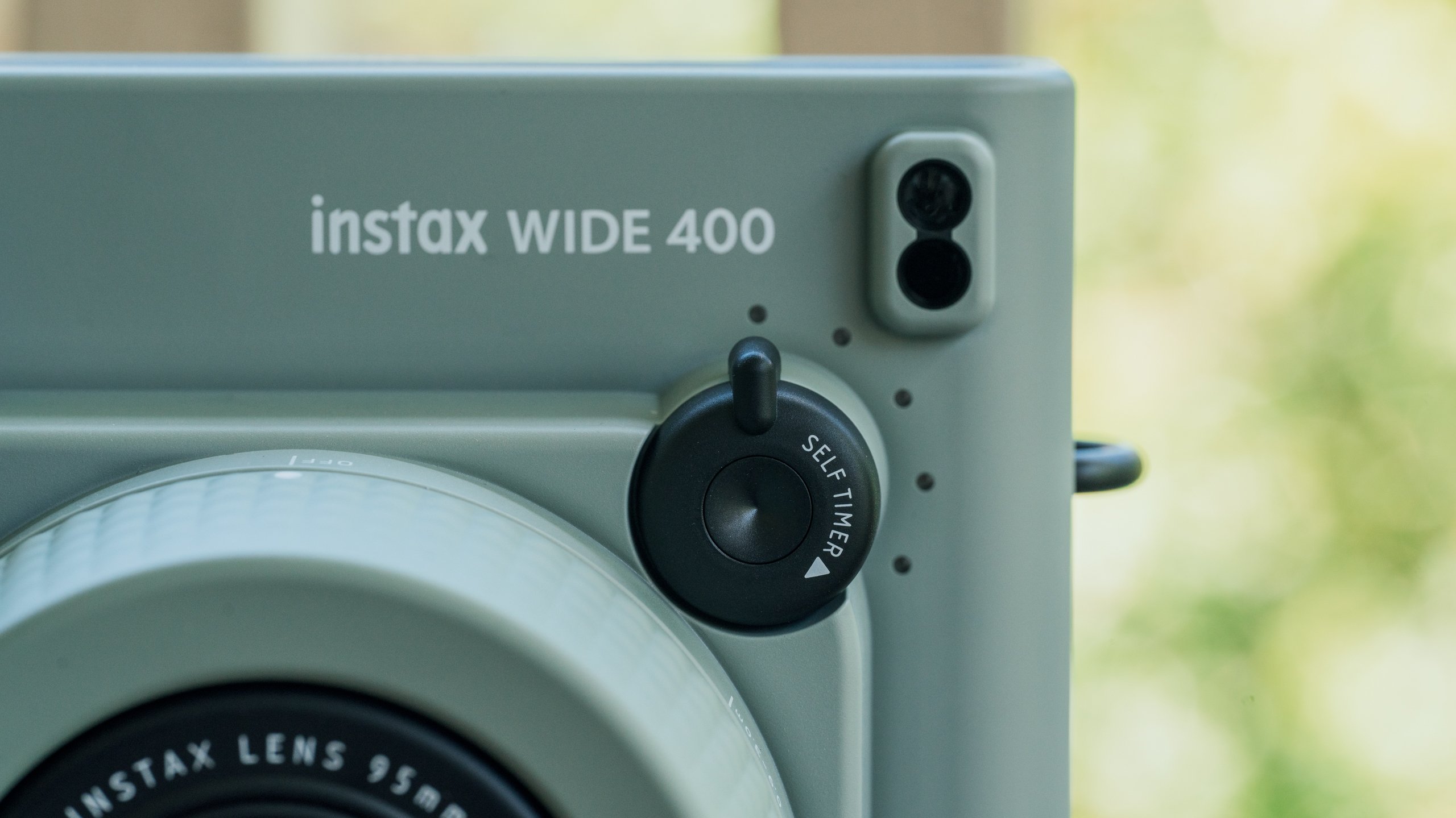 (Credit: Jim Fisher)
(Credit: Jim Fisher)The wrist strap includes a couple of small, square plastic risers that let you change the angle at which the camera sits on a flat surface. They are handy for group shots in which you don't have a tripod nearby, though the standard quarter-twenty-inch screw on the bottom means you can use a traditional support if you prefer.
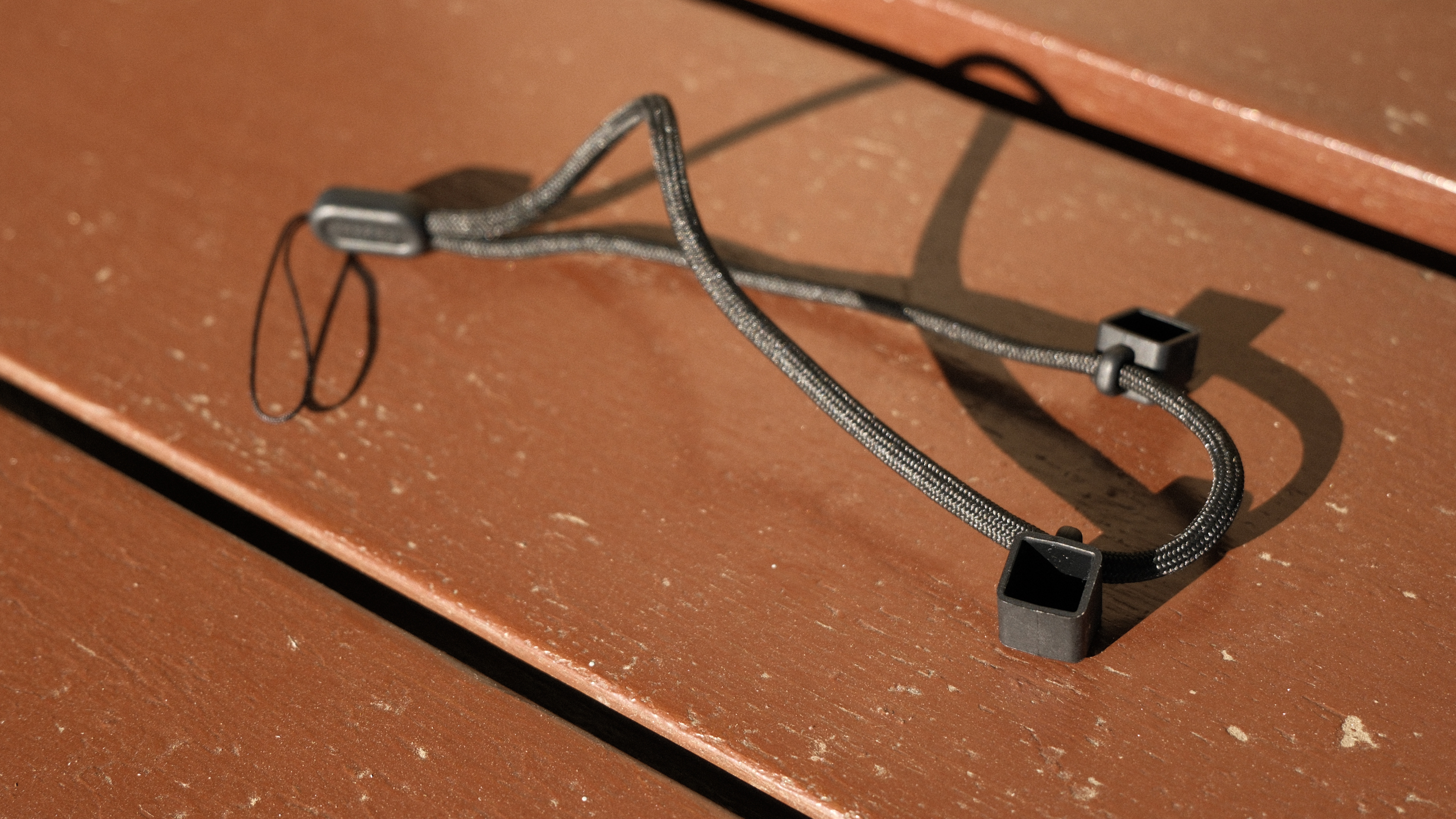
The Wide 400's lens doubles as the power control. It extends and powers up the camera with a counterclockwise twist, and retracts and powers down the device with a clockwise action. The camera supports two focus zones, and the lens has detent clicks for each. You'll need to remember to turn the lens two clicks to capture distant subjects (~10 feet to infinity) when you turn the camera on since the first click stop is for close-up photos (between 3 and 10 feet). The camera ships with a Close-up Lens attachment that snaps right onto the lens for selfies and other arm's length photos. It includes a mirror to assist with framing and shortens the focus distance to the 15.8- to 19.7-inch range.
 (Credit: Jim Fisher)
(Credit: Jim Fisher)The other Instax Wide cameras on the market are manual-focus, too. The only autofocusing instant you can buy new today is the Polaroid I-2. It bests the Fuji 400 with glass optics but relies on Polaroid I-Type instant film, which costs more and doesn't deliver consistent color. As for cameras that use Instax Wide film, the Lomo'Instant has a similar zone manual-focus lens. The premium Mint InstaKon RF70 is also manual-focus, but it includes a rangefinder window for precise results.
The optical viewfinder (OVF) sits just above the grip, opposite of where it is on the Wide 300. It provides a bright, always-in-focus view of your scene, though it has a relatively small 0.37x magnification. The OVF also has an inlaid circle marker at its center to assist you in lining up shots; it doesn't shift for parallax, but I found it accurate enough for both the lens' near and distant ranges.
 (Credit: Jim Fisher)
(Credit: Jim Fisher)If you use the Close-up Lens attachment, you need to account for the parallax effect of the off-axis viewfinder, as well as a slightly tighter angle of view. For these types of images, the OVF includes a smaller, dotted circle below and to the left of the central one that shows the center of the image, along with a few inlaid lines that indicate the smaller frame size. Even with these assists, I initially struggled to get the composition I envisioned at close working distances. I was eventually able to get better results, but you might need to set aside some time for trial and error, depending on your skill level.
Picture Quality: Largest Print Size Among Current Instants
The Instax Wide 400 offers the same picture quality as the Wide 300 since it uses identical optics. It's not quite the same lens, however, since the Wide 400 can focus a bit closer.
 (Credit: Jim Fisher)
(Credit: Jim Fisher)The 95mm f/14 lens has two plastic elements. Its angle of view is moderately wide and matches the 35mm focal length of a full-frame camera. Although the f-stop is meager, remember that Instax film is rated at ISO 800. The smaller aperture is thus an advantage when you are taking photos in bright light.
Plastic can be a dirty word in photography, but most new instant cameras (and smartphones, for that matter) employ optical plastics, too. In Wide format, the Mint InstaKon RF70 is a notable exception. It uses a 40mm-equivalent glass lens with an adjustable f/5.6-22 aperture. I haven't had a chance to review it, but pictures on a Flickr group devoted to it look good to my eye. Demanding photographers are likely to find it a better fit than the basic Wide 400.
 (Credit: Jim Fisher)
(Credit: Jim Fisher)As for picture quality, the film has more influence over the results than the lens in this case. Instax Wide's large size makes for impactful photos that are just about twice the size of the Instax Mini prints and cover a larger surface area than the squarish Polaroid I-Type film. Pictures show good detail and accurate color with some extra saturation due to their glossy finish. The plastic optics don't capture texture or fine detail with the same clarity as a digital camera or other glass lens instants, but images look sufficiently sharp for the print size.
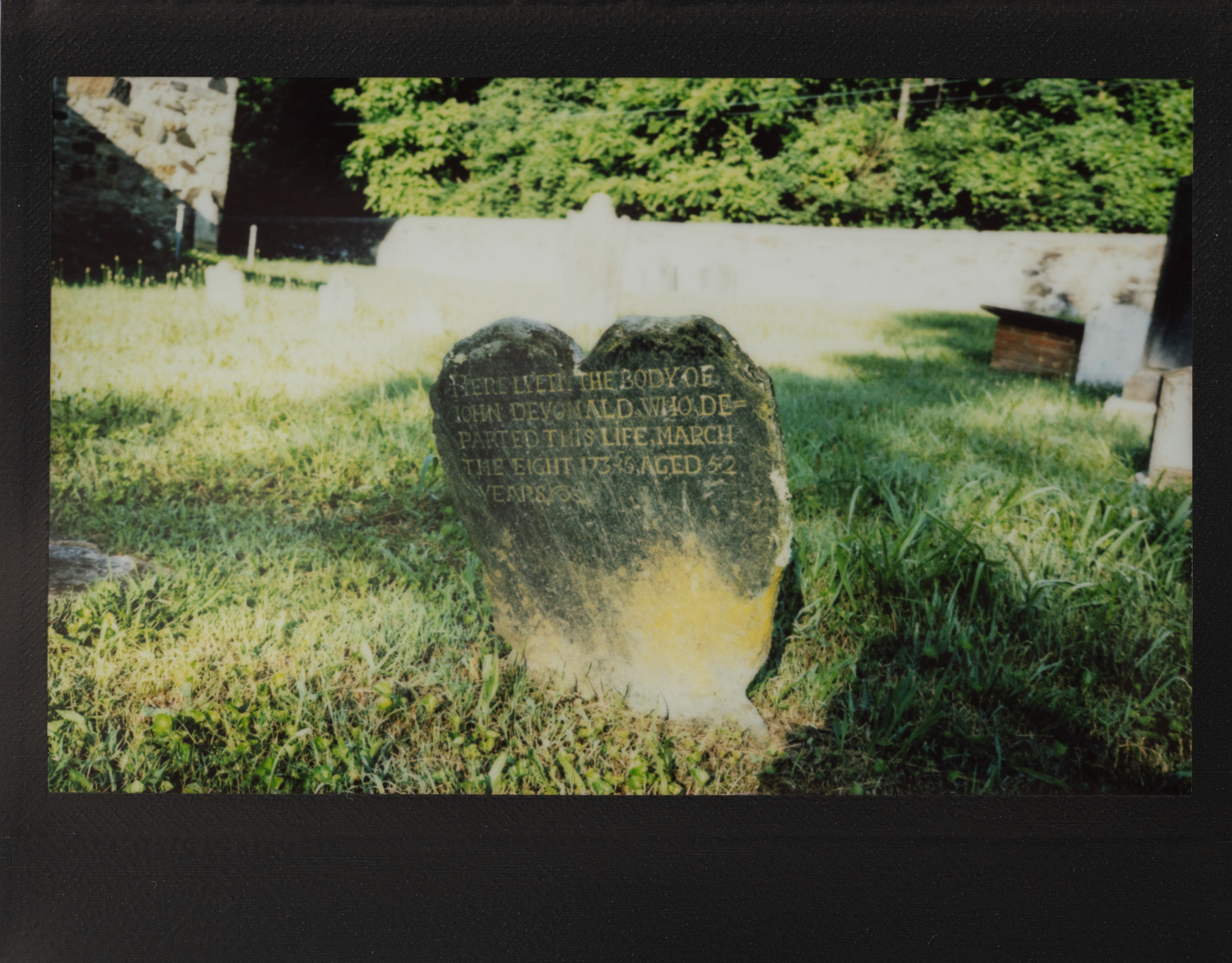 (Credit: Jim Fisher)
(Credit: Jim Fisher)You will have to contend with some flare, however. The lens suffers from a loss of contrast against a backlight and tends to show some bright blue flare if the sun hits it from an off-kilter angle. And like other instant formats (and positive slide film), the dynamic range is narrow. If you catch a scene that mixes very bright light and especially dark areas, you often end up with overly bright highlights and blackened shadows.
 (Credit: Jim Fisher)
(Credit: Jim Fisher)The Wide 400's aperture is fixed at f/14, as mentioned, and the fastest its shutter can fire is 1/200-second. You can still get properly exposed images in bright sunlight with the combination of this lens, shutter, and film speed, assuming the camera meters the scene properly. Scenes with mixed lighting are trickier. When I snapped a few images in dimmer ambient light with the rising sun strongly illuminating my subject, I ended up with overexposed highlights. That's just one situation in which EV compensation would be a huge benefit.
 (Credit: Jim Fisher)
(Credit: Jim Fisher)In low light, the flash is a requirement to get proper exposure. It does a good job for relatively close subjects—think snapshots at parties or family photos around the house—but isn't up to every task. When I tried to get the cliché interior shot of the main waiting room at Grand Central Terminal with some monochrome film, the flash fired as expected, but the pictures still came out well underexposed. Only the light coming in from the large windows at the end of the terminal is visible. I would have loved a Bulb mode for a long-exposure image in this scenario, something you get with the Lomo'Instant Wide. The Wide 400 is a no-go for most long-exposure images since the longest its shutter stays open is a brisk 1/64-second. In other words, even the tripod socket won't help you get motion-blurred nighttime scenes or landscapes with flowing water.
 (Credit: Jim Fisher)
(Credit: Jim Fisher)Instax might have limited dynamic range, but that's a typical issue for positive films. Besides, the emulsion has far fewer drawbacks than its major competitor, Polaroid I-Type. Polaroid film requires special handling—you need to block it from light as it develops, for example—and often shows defects like cobweb splotches and color cast both in cold and hot conditions. I've shot a huge quantity of Instax in my life and have never run into serious defects with the film. There's one exception: If you catch the sun or other bright point of light in your scene, it might render as a black dot in your image due to solarization. You can skip shielding it as well since the film is not prone to fogging, so you can sit back and watch an image emerge from nothing after you take a photo. Instax film starts to show a picture after about 90 seconds and fully develops in around 5 to 10 minutes.
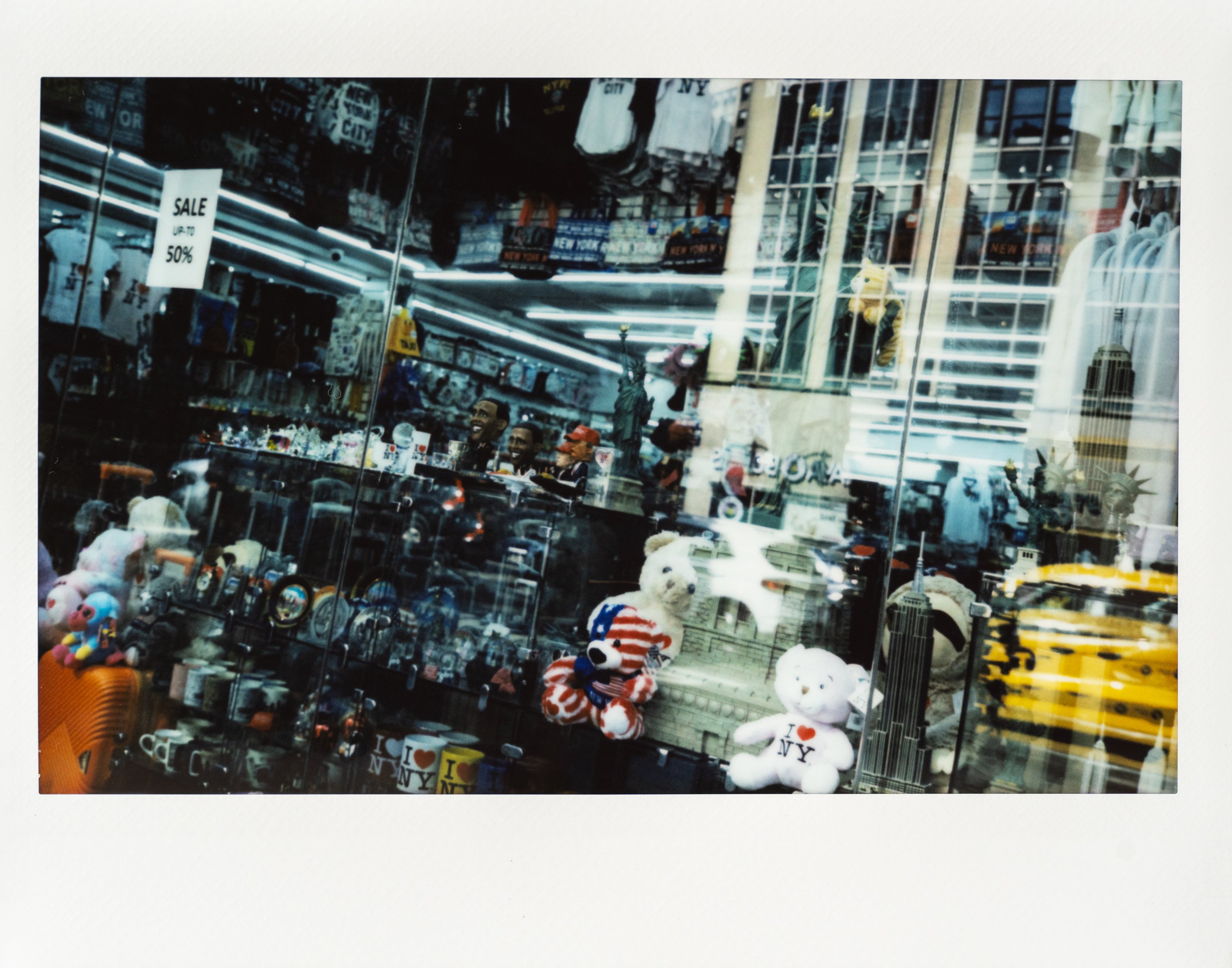 (Credit: Jim Fisher)
(Credit: Jim Fisher)Instax Wide film is also less expensive. Whereas Polaroid film comes in around $2 per exposure (or a little less if you buy in bulk), Instax Wide is around $0.90 per photo for color (or $1.50 for black-and-white). You pay for every photo you take with instant film, so film costs can add up. Like Instax Wide, Polaroid I-Type is available in either color or black-and-white formulations.
 (Credit: Jim Fisher)
(Credit: Jim Fisher)Verdict: Big, Glossy Prints, But No Creative Control
The Fujifilm Instax Wide 400 delivers oversized photos with lots of visual impact, and its one-button operation makes it accessible for non-experts. Its relatively affordable film costs, convenient use of AA batteries for power, and several focus zone modes also add to the appeal. However, long-time fans of the format might be disappointed that this camera doesn't offer more exposure control than the vintage Wide 300—or any other new headline features, for that matter. The large size of the body might also dissuade newcomers looking to experiment with instant prints. Overall, we continue to recommend the Lomo'Instant Wide as our Editors' Choice for the Instax Wide film format since it provides more creative options for a slightly higher price.


